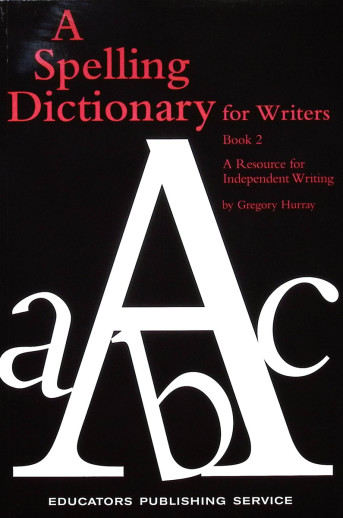We use cookies to make your experience better. To comply with the new e-Privacy directive, we need to ask for your consent to set the cookies. Learn more.
Spelling Dictionary for Writers Book 2
Parents and teachers often counter spelling questions with the response, "Look it up!". Unlike most dictionaries, which often contain more than 50,000 entries with more than a hundred on each page, this volume is designed for maximum efficiency for middle school students. It contains 5,000 words that research shows middle-schoolers use in over 95% of their writing. The alphabetized words include different forms the word can take and short definitions of words that sound the same but are spelled differently. A thesaurus is also included in the library. These pages offer multiple alternatives for overused words and expressions in the average middle-schooler's writing. Word banks for country and state names as well as thematic lists to help students write about major subjects like sports, school, and holidays will provide students with a chance to take responsibility for their own writing and will make it easier for the teacher to promote good writing.
A Spelling Dictionary for Writers is a comprehensive but accessible reference tool for improving students’ compositions and encouraging self-sufficient and resourceful writers. This book lists over 5,000 frequently used words and accounts for 95% of many middle-school level vocabularies.
About Spelling Dictionary: Based on studies of spelling and vocabulary, these handy reference books contain the most frequently used and misspelled words for students at these grade levels.
| Product Format: | Softcover Book |
|---|---|
| Brand: | Educators Publishing Service |
| Grades: | 6-8 |
| ISBN: | 9780838820575 |
| Length in Inches: | 9 |
| Width in Inches: | 6 |
| Height in Inches: | 0.25 |
| Weight in Pounds: | 0.4 |
Be the first to review this item
- Start typing and we'll see if it was already asked and answered.
- If there aren't already some matches, submit a new question.
- You'll get fast answers from customers who really own the item(s) and from our product experts. (About half the time you'll get an answer in under 2 hours!)
- Which items will best meet your needs
- What customers who own an item think of it
- How to use, fix, or take care of an item
- Product information
- General advice related to the types of products we sell
- Our store policies
For questions about an order you have placed, please contact customer support directly.











